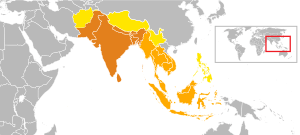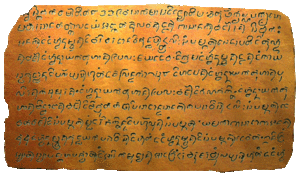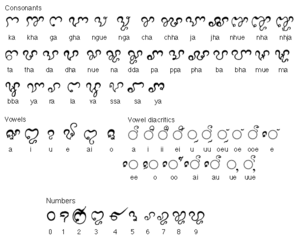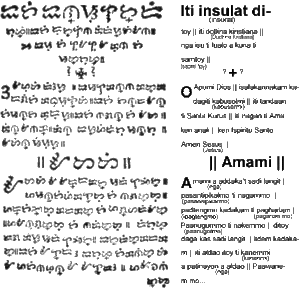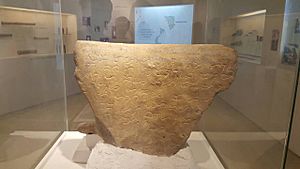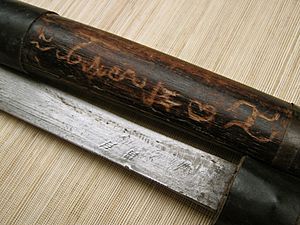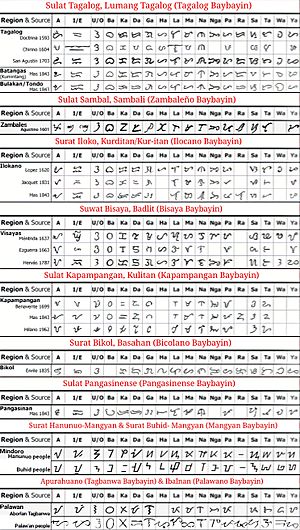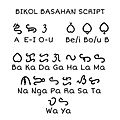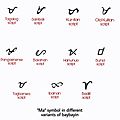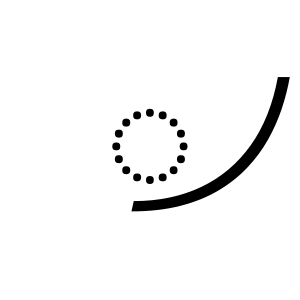Baybayin facts for kids
Quick facts for kids Baybayin |
|
|---|---|

Baybayin written in baybayin (krus-kudlit)
|
|
| Type | Abugida |
| Spoken languages | Tagalog, Sambali, Ilocano, Kapampangan, Bikolano, Pangasinan, Bisayan languages |
| Time period | 13th century (or older) – 18th century (revived in modern times) |
| Parent systems |
Proto-Sinaitic script
|
| Child systems | • Buhid script • Hanunuo script • Kulitan • Palaw'an script • Tagbanwa script |
| Sister systems | In Indonesia: • Balinese (Aksara Bali, Hanacaraka) • Batak (Surat Batak, Surat na sampulu sia) • Javanese (Aksara Jawa, Dęntawyanjana) • Lontara (Mandar) • Makasar (Jangang-jangang) • Sundanese (Aksara Sunda, Kagangaca) • Rencong (Rentjong) • Rejang (Redjang, Surat Ulu) |
| Unicode range | U+1700–U+171F |
| ISO 15924 | Tglg |
|
The theorised Semitic origins of the Brahmi script are not universally agreed upon.
|
|
| Note: This page may contain IPA phonetic symbols in Unicode. | |
Baybayin (ᜊᜌ᜔ᜊᜌᜒᜈ᜔, Tagalog pronunciation: [baɪˈbajɪn]) is an ancient Philippine writing system. It is a type of script called an abugida, which means each main character is a consonant with a built-in vowel sound. Baybayin belongs to a larger group of scripts called Brahmic scripts.
This writing system was widely used in Luzon and other parts of the Philippines. This was before and during the 16th and 17th centuries. Later, it was mostly replaced by the Latin alphabet during the Spanish colonial period. Baybayin was mainly used for the Tagalog language. It was also used in areas where Kapampangan was spoken. By the early 17th century, its use spread to the Ilocanos.
Even though it's an old script, Baybayin has survived and changed over time. It evolved into other scripts like the Tagbanwa script in Palawan, and the Hanuno'o and Buhid scripts in Mindoro. It also inspired modern scripts like the Kulitan script for Kapampangan and the Ibalnan script for the Palawan people. Today, Baybayin characters are part of the Unicode Standard, which helps computers display them.
The Archives of the University of Santo Tomas in Manila has the largest collection of old Baybayin writings in the world. These writings are kept in special rooms. The university campus, including these rooms, is being considered for the UNESCO World Heritage List.
Baybayin is mostly a historical script now. However, it is seeing a comeback in the modern Philippines. You can often find it in the symbols of government agencies. Books are also being published with some or all of their text in Baybayin. There have been many attempts in the Congress of the Philippines to pass laws that would require its use in certain situations and teach it in schools.
For modern computers, Baybayin characters are part of the Unicode system. They were first suggested for encoding in 1998. This was done by Michael Everson along with three other native Philippine scripts.
Contents
What is Baybayin?
Understanding the Name
The word baybayín means "to write" or "to spell" in Tagalog. An old dictionary from 1613 explained that baibayin meant "to spell."
Sometimes, baybayin is used to refer to other native Philippine writing systems too. These include the Buhid, Hanunó'o, Tagbanwa, and Kulitan scripts. However, groups like Sanghabi suggest using the word suyat as a general term. Suyat is a neutral word for any pre-Hispanic Philippine script.
You might also hear Baybayin called alibata. This name was made up in 1914 by Paul Rodríguez Verzosa. He based it on the first three letters of the Arabic alphabet. He wrongly thought Baybayin came from Arabic. Most experts today say that using alibata is incorrect.
In different parts of the Philippines, Baybayin has other names. The Visayans call it badlit or kudlít-kabadlit. The Ilocanos call it kurditan or kur-itan. The Bicolanos call it basahan.
Where Did Baybayin Come From?
The exact origins of Baybayin are still debated. There are several ideas about where it came from.
Indian Influence
Historically, Southeast Asia was greatly influenced by ancient India. Many kingdoms in places like Thailand, Indonesia, Malaysia, and the Philippines were shaped by Indian culture. This influence is called Indianization. It brought ideas about royalty, Hinduism, Buddhism, and the Sanskrit language.
Indian traders, priests, and warriors played a big role. Early Indian settlers in Southeast Asia came from the Pallava dynasty. They brought their Pallava script with them. Over time, these scripts changed to write local Southeast Asian languages. By the 8th century, different regional scripts had developed.
Some scholars believe Baybayin came from the Coast of Bengal in India before the 8th century. They point out that some Baybayin letters look like letters from Indian scripts. Others suggest it might be from the Gujarati script. However, Baybayin is missing marks for final consonants, which Gujarati has.
South Sulawesi Scripts
Some experts think Baybayin's direct ancestor was a script from South Sulawesi, like Old Makassar. This is because South Sulawesi scripts also don't usually show final consonants. Sulawesi is south of the Philippines, and there was trade between the two areas. This idea suggests Baybayin developed in the Philippines around the 15th century.
Kawi Script Connection
The Kawi script came from Java and was used across much of Maritime Southeast Asia. The Laguna Copperplate Inscription is the oldest known written document found in the Philippines. It's a legal paper from 900 AD, written in Kawi script. Another example is the Butuan Ivory Seal, found in the 1970s. It's an ancient ivory seal from between the 9th and 12th centuries, inscribed with "Butwan" in Kawi. Since Kawi is the earliest writing found in the Philippines, some think Baybayin might have come from it.
Cham Script Idea
Another idea is that Baybayin came to the Philippines through trade with the Champa Kingdom. Some Baybayin characters look similar to those in the Cham script. This suggests Baybayin might be more closely related to other Southeast Asian scripts than to Kawi.
Baybayin Through Time
Baybayin was used in Luzon, Palawan, Mindoro, Pangasinan, Ilocos, Panay, Leyte, and Iloilo. There's no clear evidence it reached Mindanao. It seems that the Baybayin used in Luzon and Palawan started to change differently in the 1500s, before the Spanish arrived. This suggests these were the oldest areas where Baybayin was used. The script in Pampanga even developed unique letter shapes by the early 1600s.
In the late 1500s and 1600s, there were three slightly different types of Baybayin. They weren't completely different scripts, but more like different styles of writing, similar to how Latin script had different styles across Europe.
| Script | Region | Sample |
|---|---|---|
| Baybayin | Tagalog region | |
| Sambal variety | Zambales |  |
| Kur-itan | Ilocos |  |
| Iskriturang basahan | Bicol |  |
| Pangasinan variety | Pangasinan | |
| Badlit | Visayas |  |
| Kulitan | Pampanga |  |
Early Days of Baybayin
An old pottery jar, called the "Calatagan Pot," was found in Batangas. It has markings similar to Baybayin and is thought to be from around 1300 AD. However, we're not sure if it's truly authentic.
In 1521, one of Ferdinand Magellan's crewmates, Antonio Pigafetta, said that people in the Visayas couldn't read or write. But by 1567, Miguel López de Legazpi reported from Cebu that the Visayans had their own letters, like the Malays. They wrote on bamboo or palm leaves with a pointed tool.
A century later, in 1668, Francisco Alcina wrote that the Visayans learned their writing from the Tagalogs. The Tagalogs, in turn, learned it from people from Borneo who came to Manila. He noted that women used the script more than men. In 1676, Francisco de Santa Inés explained that women used Baybayin more because they didn't go to school like boys. They used it for religious writings and other things.
The first book printed in a Philippine language was the 1593 Doctrina Christiana. It had Tagalog text in both Baybayin and the Latin alphabet. This is the oldest example of Baybayin we have today. There are also legal documents from 1591 and 1599 in Spanish and Philippine archives that include Baybayin.
Spanish priests like Pedro Chirino (1604) and Antonio de Morga (1609) said that most Filipinos knew Baybayin. They used it for personal notes, poetry, and signing documents. However, some leaders in the 1590s and witnesses in the 1620s couldn't sign documents.
In 1620, Father Francisco Lopez wrote an Ilocano Christian book. This book was important because it introduced the krus-kudlít for the first time. This mark allowed writers to show final consonants, which the original Baybayin didn't have. He said the old Baybayin was "defective" because it didn't have a way to show final consonants. However, native Baybayin users didn't adopt this new mark. They felt it went against the natural way their writing worked.
By 1703, Baybayin was still used in some areas like Batangas and Laguna.
The Ticao stone inscription, also known as the Monreal stone, is a stone tablet with Baybayin characters. It was found by students on Ticao Island in Masbate. These stones are now kept at the National Museum of the Philippines.
Why Baybayin Faded Away
Baybayin slowly fell out of use in most of the Philippines. This might have happened because of confusion over vowels and missing letters for Spanish sounds. Also, the Spanish culture and writing became more important. Learning the Latin alphabet helped Filipinos get jobs like clerks and secretaries.
By 1745, a writer named Sebastián de Totanés said that it was rare to find Filipinos who could read or write Baybayin. He noted that everyone now read and wrote in Spanish letters (the Latin alphabet).
Some people thought that Spanish priests burned many native documents. However, there is no direct proof of this. Scholars like Paul Morrow and Hector Santos say that ancient Filipinos wrote on materials like leaves and bamboo. These materials don't last long, which is why few pre-Hispanic documents survived. They also suggest that Spanish friars actually helped preserve Baybayin by writing about it and continuing to use it.
Isaac Donoso, another scholar, says that documents written in Baybayin were important in the legal system during the colonial period. Many such documents still exist today. He also believes that early Spanish missionaries did not stop the use of Baybayin. They might have even encouraged it to prevent the spread of Islamization, as Tagalog was starting to use Jawi, an Arabic-influenced script.
Modern Baybayin and Its Relatives
The only modern scripts that directly came from the original Baybayin are the Tagbanwa script (also called Ibalnan) in Palawan, and the Buhid script and Hanunóo script in Mindoro. The old Kapampangan script has been updated into the modern Kulitan script.
| Script | Region | Sample |
|---|---|---|
| Ibalnan script | Palawan | |
| Hanunó'o script | Mindoro |  |
| Buhid script | Mindoro |  |
| Tagbanwa script | Central and Northern Palawan |  |
How Baybayin Works
Baybayin is an abugida, which means its characters combine a consonant and a vowel. Each main character, called a titik, is a consonant that naturally ends with an "A" sound. To change the vowel sound, a small mark called a kudlít is added. If the kudlít is above the character, it makes an "E" or "I" sound. If it's below, it makes an "O" or "U" sound. For words starting with a vowel, there are separate characters for "A", "E/I", and "O/U".
Baybayin Characters
| Independent vowels | Base consonants (with implicit vowel a) | ||||||||||||||||||
|---|---|---|---|---|---|---|---|---|---|---|---|---|---|---|---|---|---|---|---|
a |
i/e |
u/o |
ka |
ga |
nga |
ta |
da/ra |
na |
pa |
ba |
ma |
ya |
la |
wa |
sa |
||||
Vowels
|
Ba/Va
|
Ka
|
Da/Ra
|
Ga
|
Ha
|
La
|
Ma
|
Na
|
Nga
|
Pa/Fa
|
Sa/Za
|
Ta
|
Wa
|
Ya
|
The second to last row shows the pamudpod (᜕) mark. This mark was added to the Hanunuo script to cancel vowel sounds. The last row shows the krus-kudlít (+) mark. This was added by a Spanish priest in 1620 to allow writing final consonants.
Baybayin has only one symbol for Da or Ra. This is because these sounds were often interchangeable in many Philippine languages. For example, in Tagalog, a 'd' sound often becomes an 'r' sound when it's between two vowels. However, some Baybayin versions, like Sambal, Basahan, and Ibalnan, have separate symbols for Da and Ra.
The same symbol is also used for Pa and Fa, Ba and Va, and Sa and Za. Baybayin does not use different letter cases (like capital or small letters) for proper names or the start of sentences.
-
Every baybayin variant has letters with stylistic variants, just as the tail of the letter ⟨Q⟩ can be written in different ways.
The Krus-kudlít
The original Baybayin writing style was hard for Spanish priests. This was because it didn't show the final consonant without a vowel. This could make words confusing. For example, "bundok" (mountain) would be written as "bu-du".
In 1620, Francisco López introduced his own kudlít, called a sabat or krus. This mark, shaped like a "+" sign (referring to Christianity), canceled the "A" vowel sound. This allowed a final consonant to be written. This cross-shaped kudlít works like the virama in other Brahmic scripts. Unicode even calls it "tagalog sign virama".
The Pamudpod
The pamudpod (Error using : Input "1734" is not a hexadecimal value.) is a mark used in the Hanunuo script. It also works as a virama to cancel vowel sounds. A separate pamudpod for Baybayin (Error using : Input "1715" is not a hexadecimal value.) is now part of the Tagalog Unicode block.
Punctuation and Spacing
Baybayin originally used only one punctuation mark (᜶), called Bantasán. Today, it uses two marks:
- The single punctuation (᜵) acts like a comma or separates lines in poetry.
- The double punctuation (᜶) acts like a period or marks the end of a paragraph.
These marks are similar to those in other Indian scripts. They can be written vertically or slanted. Historically, words were written without spaces. But today, spaces between words are common.
How Baybayin Was Used
Past and Present Uses
Baybayin was mainly used in Tagalog-speaking areas. Its use spread to the Ilocanos when the Spanish printed Bibles. Spanish priests noted that most Filipinos knew how to read and write Baybayin. They used it for personal writings, poetry, and signing documents. They didn't usually write long books or keep detailed records.
Traditionally, Baybayin was written on palm leaves with styli (pointed tools) or on bamboo with knives. These writing tools were called panulat. The curved shapes of Baybayin letters came from writing on these materials, as straight lines would tear the leaves. After carving letters into bamboo, ash was rubbed on them to make the characters stand out.
During the Spanish colonial period, Baybayin started to be written with ink on paper. It was also printed in books using woodcut techniques to help spread Christianity. In some areas like Mindoro, the traditional writing methods are still used. Filipinos began keeping written records of their property and church lessons in Baybayin. Documents written in Baybayin were important in the legal system of the colony. The University of Santo Tomas Baybayin Documents include two legal papers from 1613 and 1625, written in Baybayin.
Modern Day Baybayin
Several laws have been suggested to promote Baybayin, like the "National Writing System Act." Baybayin is also used on the newest Philippine peso banknotes, issued since 2010. The word "Pilipino" (ᜉᜒᜎᜒᜉᜒᜈᜓ) is written on the bills.
You can also find Baybayin in Philippine passports, specifically the latest e-passports issued from 2009 onwards. On pages 3–43, the phrase "ᜀᜅ᜔ ᜃᜆᜓᜏᜒᜇᜈ᜔ ᜀᜌ᜔ ᜈᜄ᜔ᜉᜉᜇᜃᜒᜎ ᜐ ᜁᜐᜅ᜔ ᜊᜌᜈ᜔" ("Righteousness exalts a nation") is written in Baybayin.
-
The insignia of the Order of Lakandula contains an inscription with Baybayin characters represents the name Lakandula, read counterclockwise from the top.
Examples of Baybayin
The Lord's Prayer (Ama Namin)
| Baybayin script | Latin script | English |
|---|---|---|
|
ᜀᜋ ᜈᜋᜒᜈ᜔᜵ ᜐᜓᜋᜐᜎᜅᜒᜆ᜔ ᜃ᜵ |
Ama namin, sumasalangit ka, |
Our Father who art in heaven, |
Universal Declaration of Human Rights
| Baybayin script | Latin script | English translation |
|---|---|---|
|
ᜀᜅ᜔ ᜎᜑᜆ᜔ ᜈᜅ᜔ ᜆᜂ ᜀᜌ᜔ ᜁᜐᜒᜈᜒᜎᜅ᜔ ᜈ ᜋᜎᜌ |
Ang lahát ng tao'y isinilang na malayà |
All human beings are born free They are endowed with reason and conscience |
Motto of the Philippines
| Baybayin script | Latin script | English translation |
|---|---|---|
| ᜋᜃᜇᜒᜌᜓᜐ᜔᜵ ᜋᜃᜆᜂ᜵ ᜋᜃᜃᜎᜒᜃᜐᜈ᜔᜵ ᜀᜆ᜔ ᜋᜃᜊᜈ᜔ᜐ᜶ |
Maka-Diyós, Maka-Tao, Makakalikasan, at Makabansâ. |
For God, For People, For Nature, and For Country. |
| ᜁᜐᜅ᜔ ᜊᜈ᜔ᜐ᜵ ᜁᜐᜅ᜔ ᜇᜒᜏ᜶ |
Isáng Bansâ, Isáng Diwà |
One Country, One Spirit. |
National Anthem
Below are the first two verses of the Philippine national anthem, Lupang Hinirang, in Baybayin.
| Baybayin | Latin script | IPA transcription | English translation |
|---|---|---|---|
|
ᜊᜌᜅ᜔ ᜋᜄᜒᜎᜒᜏ᜔᜵ |
Bayang magiliw, |
[ˈba.jɐŋ mɐ.ˈɡi.lɪʊ̯] |
Land of the morning, |
Example Sentences
ᜌᜋᜅ᜔
Yamang
ᜇᜒ
‘di
ᜈᜄ᜔ᜃᜃᜂᜈᜏᜀᜈ᜔᜵
nagkakaunawaan,
ᜀᜌ᜔
ay
ᜋᜄ᜔ ᜉᜃᜑᜒᜈᜑᜓᜈ᜔᜶
magpakahinahon.
Remain calm in disagreements.
ᜋᜄ᜔ᜆᜈᜒᜋ᜔
Magtaním
ᜀᜌ᜔
ay
ᜇᜒ
'di
ᜊᜒᜇᜓ᜶
birò.
Planting is not a joke.
ᜀᜅ᜔
Ang
ᜃᜊᜆᜀᜈ᜔
kabataan
ᜀᜅ᜔
ang
ᜉᜄ᜔ᜀᜐ
pag-asa
ᜈᜅ᜔
ng
ᜊᜌᜈ᜔᜶
bayan.
The youth is the hope of the country.
ᜋᜋᜑᜎᜒᜈ᜔
Mámahalin
ᜃᜒᜆ
kitá
ᜑᜅ᜔ᜄᜅ᜔
hanggáng
ᜐ
sa
ᜉᜓᜋᜓᜆᜒ
pumutî
ᜀᜅ᜔
ang
ᜊᜓᜑᜓᜃ᜔
buhók
ᜃᜓ᜶
ko.
I will love you until my hair turns white.
Baybayin on Computers
Unicode for Baybayin
Baybayin was added to the Unicode Standard in March 2002. It was part of version 3.2. In Unicode, Baybayin is called 'Tagalog'.
The Unicode range for Baybayin (Tagalog) is U+1700–U+171F.
| Tagalog[1][2] Official Unicode Consortium code chart: https://www.unicode.org/charts/PDF/U1700.pdf (PDF) |
||||||||||||||||
| 0 | 1 | 2 | 3 | 4 | 5 | 6 | 7 | 8 | 9 | A | B | C | D | E | F | |
| U+170x | ᜀ | ᜁ | ᜂ | ᜃ | ᜄ | ᜅ | ᜆ | ᜇ | ᜈ | ᜉ | ᜊ | ᜋ | ᜌ | ᜍ | ᜎ | ᜏ |
| U+171x | ᜐ | ᜑ | ᜒ | ᜓ | ᜔ | ᜕ | ᜟ | |||||||||
| Notes | ||||||||||||||||
Typing Baybayin on Keyboards
You can type Baybayin directly from your keyboard without needing special online tools.
Gboard
The virtual keyboard app Gboard by Google added support for Baybayin on August 1, 2019. This update included all Unicode suyat scripts. When you use the "Filipino (Baybayin)" layout, you can easily select vowel marks (kudlít) and the virama (vowel cancellation mark).
Philippines Unicode Keyboard Layout
There's a special keyboard layout for the Philippines that includes Baybayin. It works with different keyboard types like QWERTY and Dvorak. You can use it on both Microsoft Windows and Linux.
You can download this keyboard layout here.
See also
 In Spanish: Baybayin para niños
In Spanish: Baybayin para niños
- Filipino orthography
- Suyat
- Buhid script
- Hanuno'o script
- Tagbanwa script
- Kulitan
- Basahan
- Kawi
- Tagalog language
- Old Tagalog
- History of Indian influence on Southeast Asia
- Abugida


